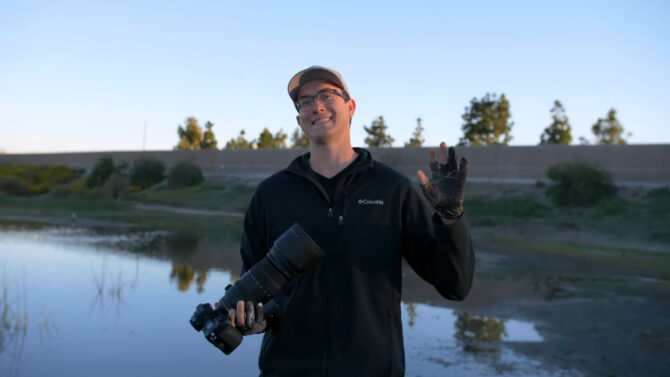Filming animals, whether domestic or wild, is an art that requires patience, skill, and a deep understanding of animal behavior. Capturing these magnificent creatures in their natural habitat or even in a controlled environment can yield stunning footage but comes with its own set of challenges.
Today, we’ll explore seven essential tips that can dramatically improve your animal filming experience and results.
1. Know the Animal Behavior
To film animals effectively, it’s crucial to understand their behavior. Different species have unique characteristics, patterns, and temperaments. This knowledge not only helps in anticipating their actions for better shots but also ensures safety for both the filmmaker and the animal.
Researching your subject thoroughly before the shoot can provide invaluable insights into their daily routines, feeding habits, and interaction with their environment.
For example, what do squirrels eat? We know they eat nuts but is it the only thing? Do your research on time before going on your filming trip.
Observational Skills
Observation is key when filming animals. Spend time watching your subjects without the camera. Notice how they move, interact, and react to various stimuli. This understanding will allow you to predict movements and capture more natural, compelling footage.
It also helps in identifying the right moments to start filming, such as when an animal is about to leap or engage in a unique behavior.

Respect and Patience
Filming animals demands a great deal of patience. Respect their space and avoid causing any stress or disturbance. Remember, you are a guest in their world. Maintain a safe and respectful distance, use long lenses when necessary, and be prepared to wait for hours or even days to get the perfect shot.
Patience pays off in wildlife filming, often leading to those rare, once-in-a-lifetime shots.
2. Equipment and Preparation
Selecting the right equipment is critical for filming animals. A good quality camera with high resolution and frame rate options is essential.
Lenses are equally important – a mix of wide-angle and telephoto lenses can be useful, depending on the distance and size of the animal.
Last but not least, consider stabilizing gear like tripods or gimbals, especially for long hours of shooting.

Preparation Matters
Preparation is key in wildlife filmmaking. Ensure all your equipment is in working order before heading out.
Pack extra batteries, memory cards, and any necessary protective gear for your equipment. It’s also wise to familiarize yourself with your gear, so you can operate it efficiently when a fleeting opportunity arises.
Adapting to Environments
When filming in different environments, whether it’s a dense forest, a desert, or underwater, your equipment and approach need to adapt.
Use protective cases in harsh weather conditions, and consider using camouflage to blend in with the environment. This not only protects your gear but also minimizes your presence, allowing for more natural animal behavior.
3. Lighting and Composition

Lighting plays a pivotal role in the quality of your footage. The best animal filming often occurs during the golden hours of sunrise and sunset when the light is soft and warm.
Utilizing natural light will enhance the visual appeal of your shots. Be mindful of the direction and quality of light, and adjust your position accordingly to get the best shots.
Composition Techniques
Composition is crucial in storytelling. Use techniques like the rule of thirds, leading lines, or framing to create visually compelling shots.
Be conscious of the background and avoid cluttered or distracting elements. Sometimes, a change in angle or perspective can turn an ordinary shot into an extraordinary one.
Capturing Emotion and Action
Aim to capture emotions and actions that convey a story. Close-ups can reveal intricate details and expressions, while wide shots can illustrate an animal’s interaction with its environment.
Anticipate action sequences, like a bird taking flight or a predator on the hunt, to add dynamic elements to your footage.
4. Sound and Silence

Sound is a powerful tool in wildlife filmmaking. Natural ambient sounds, such as bird calls, rustling leaves, or running water, can greatly enhance the immersive experience of your footage.
Use a high-quality microphone and practice capturing clear, undisturbed sound to complement your visuals.
Importance of Silence
Respect the power of silence in wildlife filming. Sometimes, the absence of sound can be as impactful as its presence. It can emphasize a particular visual or create a moment of suspense. Be aware of your own noise levels during filming and strive to be as quiet as possible to avoid disturbing the animals or altering their natural behavior.
Editing Sound Post-Production
In post-production, sound editing can significantly improve your final product. Balance the levels between ambient sounds and any added music or narration. Ensure the sound is clear, and eliminate any distracting noises. Sound editing can also help in creating a narrative flow and enhancing the emotional impact of your footage.
5. Ethical Considerations
Ethical considerations are paramount in wildlife filming. Always prioritize the welfare of the animals over getting a shot.
Avoid any actions that might disturb, harm, or alter the natural behavior of the animals. This includes feeding, baiting, or using artificial light or sound to attract or manipulate animals.
Environmental Impact
Be mindful of your impact on the environment. Stick to designated paths, avoid trampling vegetation, and ensure that your presence does not negatively affect the habitat.
Leave no trace behind – this principle is crucial in preserving natural ecosystems for future generations and for the continued existence of the wildlife you are filming.
Legal and Cultural Sensitivity
Understand and adhere to local laws and regulations related to wildlife and environmental conservation. This includes permits for filming in certain areas or restrictions on approaching endangered species.
Also, be culturally sensitive, especially when filming in foreign locations. Respect local customs and traditions, and engage with local communities to understand their relationship with the wildlife and environment.
6. Safety and Survival Skills
Filming animals, particularly in the wild, can pose risks. Equip yourself with basic survival skills and knowledge of first aid.
Be aware of potential dangers, such as predatory animals or challenging terrain. In remote or potentially hazardous locations, consider having a guide or wildlife expert with you.
Preparing for Emergencies
Always have a plan for emergencies. This includes informing someone about your location and expected return time, carrying a means of communication, and having an emergency kit.
Be prepared for sudden weather changes or unexpected situations, and know the basics of navigating in the wilderness.
Wildlife Safety
Respecting wildlife safety is as important as your own. Understand the signs of distress or aggression in animals and know how to respond or retreat if necessary.
Maintain a safe distance, use zoom lenses to minimize close interaction, and never attempt to touch or feed wild animals.
7. Post-Production and Storytelling
Post-production is where your footage transforms into a compelling story. Edit with a narrative in mind – this could be the life cycle of an animal, a day in the life of a species, or an environmental message.
Be selective with your shots, choose the best angles, and maintain a pace that keeps the audience engaged.
For those looking to take their editing to the next level, the creative suite by CapCut offers a comprehensive set of tools for video editing, graphic design, and more, infused with advanced AI technology to enhance your creative journey.
In this phase, using a reliable video compressor is also highly important. This tool allows you to compress the size of your video without losing quality, ensuring your wildlife footage retains its visual integrity while being easy to share and store.

Narration and Music
Narration and music can greatly enhance your wildlife film. A well-written narration can provide context, information, and emotional depth.
Music should complement the visuals and the mood of the film without overpowering the natural sounds or the narrative.
Sharing Your Work
Finally, consider the platforms for sharing your work. Whether it’s a documentary, a short film for social media, or a submission to a film festival, tailor your editing and format to suit your audience and medium.
Engage with your audience, seek feedback, and use your work to raise awareness and appreciation for the natural world.
Final Words
Filming animals is a rewarding venture that combines art, science, and a deep respect for nature. Follow these seven tips, and you will be able to create stunning, impactful wildlife films like a pro.
It’s crucial to remember that the goal is not just to capture beautiful footage but to tell a story that connects the audience with the natural world, which, ultimately, creates a deeper understanding and appreciation of the animals.






